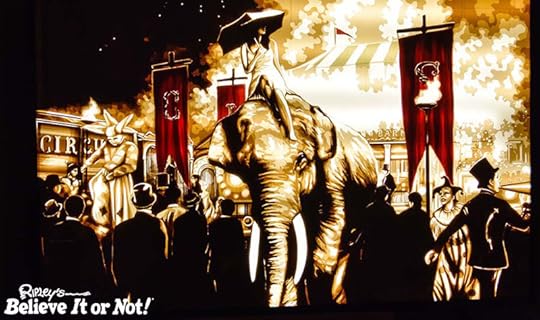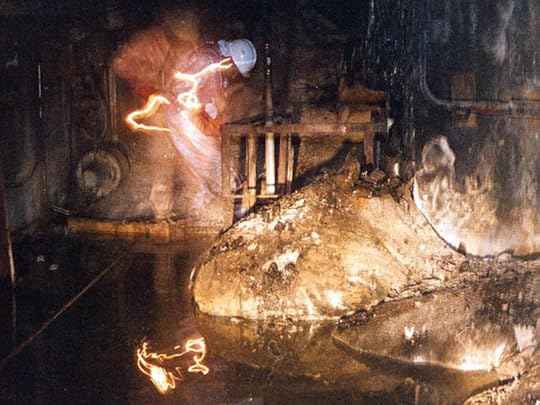Ripley Entertainment Inc.'s Blog, page 414
April 30, 2017
CARTOON 04-30-2017
April 29, 2017
CARTOON 04-29-2017
April 28, 2017
CARTOON 04-28-2017
April 27, 2017
This Artist’s Packing Tape Art is Stunning
Featured in Ripley's Believe It or Not!

We were so impressed with Max Zorn’s packing tape art in 2013, that we bought several to include in our Odditoriums, and now he’s done it again.
Zorn started his art career in Amsterdam as a street artist decorating street lamps. Intrigued by light and shadows, he experimented with transparent mediums, like brown packing tape, on top of light sources to see if pictures could be formed by the light shining through.
His stunning city-scapes were made using multiple layers of the tape to create shadow and depth, before being lit from behind to provide a truly unique piece of art. The piece featured in the video above is now in our London Odditorium.
Since we last saw him, Zorn has added color to his portraits. The vintage sepia feel has become even more dynamic and striking.
See For Yourself:



CARTOON 04-27-2017
Inventor of the Telegraph, Samuel Morse, Was an Artist
Featured in Ripley's Believe It or Not!

Born in 1791, Samuel Morse, the man credited with inventing the telegraph and launching the communication revolution, was originally an artist. His turn to electronics came only after the tragic death of his wife.
Inspired by his Calvinist upbringing, Sam Morse combined his classical training in Renaissance art at the Royal Academy with a unique religious American experience to create pieces that were both political and spiritual.

Dying Hercules
Morse became such a popular artist that he was commissioned to do portraits of presidents John Adamas and James Monroe, along with technology magnate Eli Whitney.
Tragedy and Turn to Science
While working on a portrait in Washington DC, Morse’s wife fell ill. Before the news could even reach him, his beloved had died and was buried.
Morse was so distraught over the tragedy that he spent the rest of his life working on a way for people to communicate instantaneously.
Partnering with Charles Thomas Jackson–an expert in electromagnetism–Morse developed the concept of a single-wire telegraph. This device used a series of on-off tones to carry coded messages vast distances using wire. To translate these messages, he also invented Morse Code, which translated the electric pulses into letters.
“What hath God wrought?” -the first telegram, Samuel Morse

Morse’s telegraph.
Source: Inventor of the Telegraph, Samuel Morse, Was an Artist
April 26, 2017
Atomic Tourism: Vegas Visitors Watch Nukes Explode
Featured in Ripley's Believe It or Not!

Las Vegas is known as the city of lights and, at one time, that light was the glow of a nuclear detonation in the Nevada desert.
“It turned night into day.” -Allen Palmer, executive director for the National Atomic Testing Museum
Starting in 1951, the US Department of Energy began testing nuclear ordinances just 65 miles from the city of Las Vegas. At night, the glow of the bombs lit up the sky, and mushroom clouds could be spotted rising over the horizon during the day.
Atomic tourism drew people from all over to see these devices of ultimate destruction. Mushroom clouds showed up on billboards, in hairstyles, and even costumes. There was literal pageantry as Las Vegas named the official “Miss Atomic Bomb”.

Courtesy Las Vegas News Bureau
Casinos jumped at the chance to use their roofs for exclusive atomic cocktail parties, and tourism officials posted guides on the best places to watch the bombs. Detonations were even announced in advance to ensure nobody missed them.
“The best thing to happen to Vegas was the atomic bomb.” – Benny Binion, casino owner
A Nuclear Society
Tests continued in the Nevada Desert until 1963, when the US signed a ban on above-ground testing. Despite the ban, over 900 bombs were tested outside the city between 1951 and 1992.
Ironically, all this spectacle and fascination was embedded in the midst of crippling worry over nuclear doomsday. During the same time, children were being told to hide under their desks in preparation for a nuclear attack. Schools even issued dog tags to children so they could be identified in case of an accident at the testing facility.

CC James Vaughan via Flickr
While the Vegas economy exploded with the bombs, so did concerns about dangerous radiation exposure. Soldiers viewing nuclear bombs showed significantly higher risks of cancer and a high chance of deformity in offspring, but military officials at the time said that residents of Las Vegas could just shower if they were exposed.

Courtesy Las Vegas News Bureau
CARTOON 04-26-2017
Chernobyl’s Deadly Elephant’s Foot
Featured in Ripley's Believe It or Not!


Aftermath of the disaster|CC Soviet Authorities
On April 26, 1986, during a routine test, the Number 4 reactor at the Chernobyl Nuclear Power Plant had a power surge and triggered an emergency shutdown.
Instead of shutting down, the reactor kept surging power, and in no time at all the plant was in full disaster mode.
The control rods used to manage the core’s temperature were inserted too late into the process. Instead of cooling down, the rods cracked in the rising heat from the core and locked into place.
As if that wasn’t bad enough, the water used to cool the entire reactor vaporized, resulting in a massive explosion. The first explosion blew the 4-million pound lid of the reactor through the roof of the building. The second explosion followed shortly thereafter and sent broken core material, fire, and radioactive waste into the air.
Without the tons of steel and concrete typically used to shield it, the core of the reactor began to melt. The result of the melting process is a substance called Corium.
Corium is a lava-like molten mixture of portions of the nuclear reactor core, nuclear fuel, fission products, and control rods.
At Chernobyl, the corium melted through the bottom of the reactor vessel, oozed through pipes, ate through concrete, and eventually cooled enough to solidify.

CC US Department of Energy
The Elephant’s Foot
The spot where the corium solidified wouldn’t be discovered until December in 1986. To contain the fallout, a large concrete enclosure named the sarcophagus was built on the site. Access points were left in the sarcophagus for researchers.
During one such research trip, their equipment registered levels of radiation so high that it would kill anyone who got too close for more than a few second.
In order to see what was causing the readings, the scientist attached a camera to a wheeled contraption and rolled it in the direction the readings were emanating.
What they saw was dubbed the Elephant’s Foot.

CC US Department of Energy
The Elephant’s Foot is so deadly that spending only 30 seconds near it will result in dizziness and fatigue. Two minutes near it and your cells will begin to hemorrhage. By the time you hit the five-minute mark, you’re a goner.
Even after 30 years, the foot is still melting through the concrete base of the power plant. Its existence makes the city uninhabitable to humans for at least the next 100 years. If it melts down into a source of ground water, it could trigger another explosion or contaminate the water of nearby villages.
And yet, in spite of the Elephant Foot’s toxic presence in Chernobyl, something strange is happening.
Animals Flourish
Biologists from the University of Georgia set up cameras in the Belarus evacuation zone to try and track animal activity in the area. What they found was surprising.
Many different kinds of animals aren’t simply living in the irradiated area; they’re thriving in it.
Embed from Getty Images
The cameras spotted gray wolves, red foxes, wild boars, moose, and deer.
It’s not that the area isn’t still dangerous to humans, but instead, the animal life seems to have found a way to thrive in spite of it. And even more important than that, the flourishing animal life shows just how destructive the presence of human beings can be on the animal population of any given area.
Whatever the reason, the area of the Chernobyl disaster has become a kind of wildlife refuge for many different species of animals. At least some small amount of good was able to come from one of the worst disasters in the last three decades.
Embed from Getty Images
April 25, 2017
Escape to the Island of the Dolls
Featured in Ripley's Believe It or Not!

From Anabelle to Chucky, dolls have haunted our childhood dreams for centuries. And now, there’s an island embellished with hundreds of decaying dolls, some decapitated, others amputated, just south of Mexico City.

CC Wa17gs via Wikimedia Commons
The Legend
While this land might be morbidly fascinating and attract many tourists, there’s a disturbing yet touching story behind this island.
According to legend, around 1950 Don Julian Santana abandoned his wife and child to live reclusively on Teshuilo Lake in the Xochimilco canals. Upon his arrival, he found a young girl that drowned accompanied by her floating doll.

CC Emmanuel Eslava
To honor her spirit, Santana began to transform the island into a shrine, collecting hundreds of dolls from the canals around him as well as in the trash for 50 years. Eventually, word got out, and people began to flock to the island, and for a small price, began to show visitors his land.

Locals claim the dolls come alive at night, opening their eyes and whispering to one another. CC Px-lga via Wikimedia Commons
Ironically in 2001, Santana was found dead in the same spot where he had encountered the little girl. The family till this day, claim the girl was just a figment of his imagination.
The Island Now
As local lore would deem fit, the dolls come to life during the night, consumed by the girl’s spirit; however, the dolls are still kept hanging high to protect the island from evil spirits.
Visitors say the island’s atmosphere feels calm and peaceful, but at times can be a little nerve-wracking as you feel the dolls staring at you.
While considered a labor of love, this accidental sensation has allowed the saga of this bizarre island to live on forever.

These mutilated dolls have turned this island into a tourist attraction. CC Wa17gs via Wikimedia Commons
Interested in visiting? Well, you can catch a 4-hour ferry from Embarcedero Cuemanco…if you dare that is.
Ripley Entertainment Inc.'s Blog
- Ripley Entertainment Inc.'s profile
- 52 followers






 CARTOON 04-26-2017
CARTOON 04-26-2017
